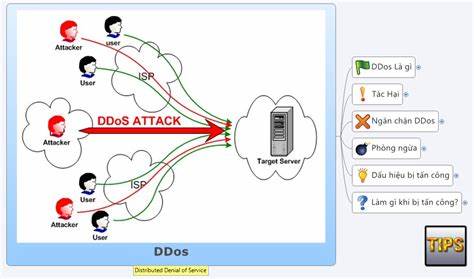Have you ever tried to visit a website, only to find that it’s completely inaccessible? You might have thought it was just bad luck or a server issue. But what if I told you that this could be the result of a Distributed Denial-of-Service (DDoS) attack? In today’s increasingly digital world, DDoS attacks are a serious threat to online businesses, services, and even individuals. But what exactly is a DDoS attack, and how can you protect yourself from becoming a victim? Learn about Distributed Denial-of-Service (DDoS) attacks, how they disrupt online services and essential strategies for protection.
What is a Distributed Denial-of-Service (DDoS) Attack?
A Distributed Denial-of-Service (DDoS) attack is a malicious attempt to disrupt the normal functioning of a targeted server, service, or network by overwhelming it with a flood of internet traffic. Unlike a traditional Denial-of-Service (DoS) attack, which typically involves a single source, a DDoS attack uses multiple compromised devices, often spread across the globe, to launch the attack simultaneously.
These compromised devices, also known as a “botnet,” are often infected with malware and controlled remotely by the attacker. Once activated, the botnet sends massive amounts of traffic to the target, causing it to become slow, unresponsive, or completely inaccessible to legitimate users.
How Do DDoS Attacks Work?
Understanding how DDoS attacks work requires a look at the basic mechanisms behind them. The goal of a DDoS attack is to exhaust the target’s resources, such as bandwidth, memory, or processing power, by overwhelming it with traffic. Here’s a step-by-step breakdown of how these attacks typically unfold:
1. Building a Botnet
The first step in executing a DDoS attack is to create a botnet. Attackers use various techniques, such as phishing emails or exploiting security vulnerabilities, to infect multiple devices with malware. These devices, once compromised, become part of the botnet and can be controlled remotely by the attacker.
2. Launching the Attack
Once the botnet is ready, the attacker commands it to send a massive amount of traffic to the target. This traffic can take many forms, such as HTTP requests, ping messages, or data packets. The sheer volume of traffic overwhelms the target’s resources, causing it to slow down or crash.
3. Disrupting Service
As the target becomes overwhelmed, legitimate users may find that they are unable to access the website or service. This disruption can last for hours or even days, depending on the severity of the attack and the target’s ability to mitigate it.
Types of DDoS Attacks
DDoS attacks come in various forms, each targeting different aspects of a network’s infrastructure. Understanding the different types of DDoS attacks can help you better prepare for and defend against them. Here are the three most common types:
1. Volume-Based Attacks
Volume-based attacks aim to overwhelm the target’s bandwidth by flooding it with a massive amount of traffic. This type of attack is often measured in bits per second (bps) and can involve sending large data packets or a high number of requests. Common examples include UDP floods and ICMP floods.
2. Protocol Attacks
Protocol attacks target weaknesses in the network protocols themselves. These attacks consume server resources or network equipment, such as firewalls and load balancers, by exploiting protocol vulnerabilities. Examples include SYN floods and Smurf attacks.
3. Application Layer Attacks
Application layer attacks focus on specific applications or services running on the target server. These attacks are often more sophisticated and harder to detect because they mimic legitimate user behavior. Examples include HTTP floods and DNS query floods.
Why Are DDoS Attacks So Dangerous?
DDoS attacks are particularly dangerous because they can cause significant financial and reputational damage to organizations. Here’s why these attacks are so concerning:
1. Financial Losses
For businesses that rely on online services, a DDoS attack can result in lost revenue. If customers are unable to access a website or service, they may take their business elsewhere. Additionally, the cost of mitigating an attack, including hiring security experts and investing in DDoS protection services, can be substantial.
2. Reputational Damage
A successful DDoS attack can tarnish a company’s reputation. Customers expect online services to be available 24/7, and any downtime can lead to frustration and a loss of trust. In the long term, this can result in a decline in customer loyalty and a negative impact on the brand’s image.
3. Data Breaches
In some cases, a DDoS attack may be used as a smokescreen for other malicious activities, such as data breaches. While the target is busy dealing with the flood of traffic, attackers may attempt to infiltrate the network and steal sensitive information.
How to Protect Against DDoS Attacks
Given the serious threat that DDoS attacks pose, it’s crucial to have a plan in place to protect your network. Here are some key strategies for defending against DDoS attacks:
1. Invest in DDoS Protection Services
One of the most effective ways to protect against DDoS attacks is to invest in specialized DDoS protection services. These services use advanced technology to detect and mitigate DDoS attacks before they can cause significant damage. Cloud-based solutions, in particular, can absorb and filter malicious traffic, allowing legitimate traffic to reach your server.
2. Implement Rate Limiting
Rate limiting is a technique that restricts the number of requests a user can make to a server within a certain period. By implementing rate limiting, you can reduce the risk of your server being overwhelmed by a flood of requests during a DDoS attack.
3. Monitor Network Traffic
Constantly monitoring your network traffic is essential for identifying potential DDoS attacks early. By setting up alerts for unusual traffic patterns, you can respond quickly to an attack and minimize its impact.
4. Have a Response Plan
Every organization should have a response plan in place for dealing with DDoS attacks. This plan should include steps for identifying the attack, mitigating its effects, and communicating with stakeholders. Having a clear plan can help you respond more effectively in the event of an attack.
The Future of DDoS Attacks
As technology continues to evolve, so too do the methods used by cybercriminals. The future of DDoS attacks is likely to see an increase in complexity and scale, making it even more challenging for organizations to defend against them.
1. Emerging Threats
One of the emerging threats in the world of DDoS attacks is the use of IoT (Internet of Things) devices. As more and more devices become connected to the internet, they become potential targets for attackers looking to create larger and more powerful botnets.
2. AI-Powered Attacks
Another potential threat is the use of artificial intelligence (AI) to launch and coordinate DDoS attacks. AI could be used to identify vulnerabilities in real-time, making it harder for traditional defense mechanisms to keep up.
Conclusion
In conclusion, Distributed Denial-of-Service (DDoS) attacks are a serious threat that can have devastating consequences for businesses and individuals alike. By understanding how these attacks work, recognizing the different types, and implementing strong defense strategies, you can better protect yourself from becoming a victim. As the digital landscape continues to evolve, staying informed about emerging threats and investing in robust security measures will be crucial.







